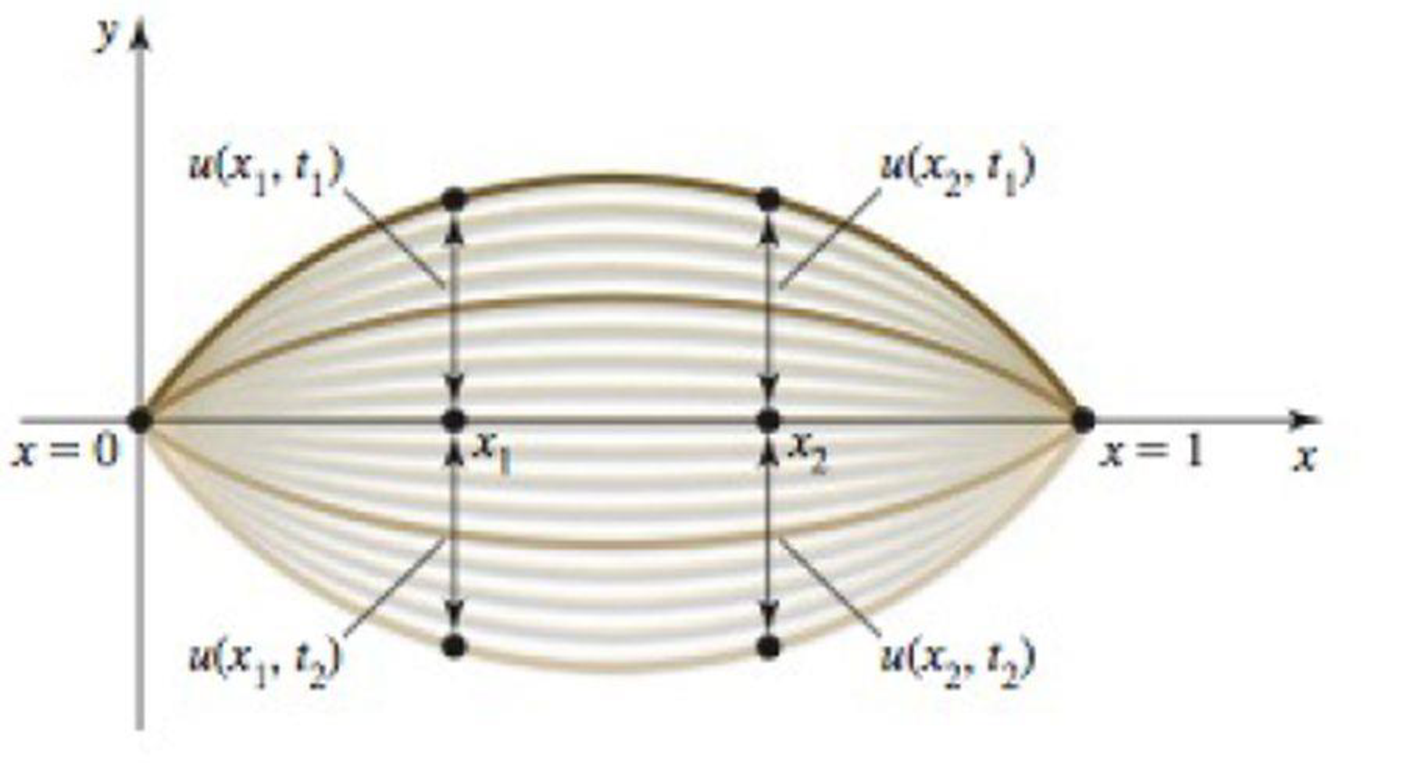
Concept explainers
Wave on a string Imagine a string that is fixed at both ends (for example, a guitar string). When plucked, the string forms a standing wave. The displacement u of the string varies with position x and with time t. Suppose it is given by u = f(x, t) = 2 sin (πx) sin (πt/2), for 0 ≤ x ≤ 1 and t ≥ 0 (see figure). At a fixed point in time, the string forms a wave on [0, 1]. Alternatively, if you focus on a point on the string (fix a value of x), that point oscillates up and down in time.
a. What is the period of the motion in time?
b. Find the rate of change of the displacement with respect to time at a constant position (which is the vertical velocity of a point on the string).
c. At a fixed time, what point on the string is moving fastest?
d. At a fixed position on the string, when is the string moving fastest?
e. Find the rate of change of the displacement with respect to position at a constant time (which is the slope of the string).
f. At a fixed time, where is the slope of the string greatest?

Trending nowThis is a popular solution!

Chapter 15 Solutions
Calculus Early Transcendentals 3rd.edition I.r.c.
Additional Math Textbook Solutions
College Algebra with Modeling & Visualization (5th Edition)
A First Course in Probability (10th Edition)
A Problem Solving Approach To Mathematics For Elementary School Teachers (13th Edition)
Pre-Algebra Student Edition
Calculus: Early Transcendentals (2nd Edition)
Calculus for Business, Economics, Life Sciences, and Social Sciences (14th Edition)
- Explain the relationship between 12.3.6, (case A of 12.3.6) and 12.3.7arrow_forwardExplain the key points and reasons for the establishment of 12.3.2(integral Test)arrow_forwardUse 12.4.2 to determine whether the infinite series on the right side of equation 12.6.5, 12.6.6 and 12.6.7 converges for every real number x.arrow_forward
- use Corollary 12.6.2 and 12.6.3 to derive 12.6.4,12.6.5, 12.6.6 and 12.6.7arrow_forwardExplain the focus and reasons for establishment of 12.5.1(lim(n->infinite) and sigma of k=0 to n)arrow_forwardExplain the focus and reasons for establishment of 12.5.3 about alternating series. and explain the reason why (sigma k=1 to infinite)(-1)k+1/k = 1/1 - 1/2 + 1/3 - 1/4 + .... converges.arrow_forward
- Explain the key points and reasons for the establishment of 12.3.2(integral Test)arrow_forwardUse identity (1+x+x2+...+xn)*(1-x)=1-xn+1 to derive the result of 12.2.2. Please notice that identity doesn't work when x=1.arrow_forwardExplain the key points and reasons for the establishment of 11.3.2(integral Test)arrow_forward
- Algebra & Trigonometry with Analytic GeometryAlgebraISBN:9781133382119Author:SwokowskiPublisher:Cengage
 Trigonometry (MindTap Course List)TrigonometryISBN:9781305652224Author:Charles P. McKeague, Mark D. TurnerPublisher:Cengage Learning
Trigonometry (MindTap Course List)TrigonometryISBN:9781305652224Author:Charles P. McKeague, Mark D. TurnerPublisher:Cengage Learning

